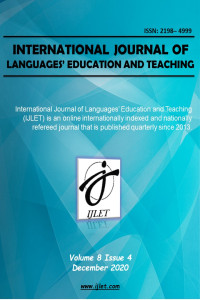Paydaşların ve Sosyal Medya Kullanıcılarının Görüşlerine Göre Çocuklara Yönelik Yabancı Dil Olarak Türkçe Öğretimi
Abstract
Çocuklara yönelik yabancı dil olarak Türkçe öğretimi (ÇYDTÖ) alanında yürütülen çalışmaların artması ve gelişmesi son on yılda
yaşanan siyasi ve kültürel olayların sonucunda gerçekleşmiştir. 2011 yılında başlayan Suriye Savaşı sonrasında yaşanan
gelişmelerin sonucunda ÇYDTÖ alanında çalışmalar yapmak bir zorunluluk hâline gelmiştir. Ülkemizde Türkçe öğrenen çocuk
sayısının olağanın üstünde bir seyirle artması, ÇYDTÖ alanındaki mevcut öğretim programı ve öğretim kaynaklarının yetersiz
kalmasına neden olmuştur. Bu çalışmanın amacı, 7-11 yaş arasındaki çocuklara yönelik yabancı dil olarak Türkçe öğretimi
alanında karşılaşılan öğretim ve programa ilişkin problem ve ihtiyaçları ortaya koymaktır. Olgubilim deseninde nitel bir
araştırma olan ihtiyaç analizi çalışmasında paydaşlar ile görüşmeler yapılmış ve öğretmenlerin paylaşımlarının olduğu sosyal
medya analizleri yapılmıştır. Katılımcılar ölçüt örnekleme yöntemi kullanılarak belirlenmiştir. Araştırmada çocuklara Türkçe
öğreten on altı Türkçe öğretmeni, üç öğretim elemanı, üç öğrenci velisi ve üç sivil toplum kuruluşu (STK) temsilcisiyle görüşmeler
yapılmıştır. Yabancılara Türkçe öğretimi ile ilgili kurulmuş olan sosyal medyadaki paylaşımlar da analiz edilmiştir. Veri
analizinin sonucunda elde edilen bulgular; ÇYDTÖ’nde programın yetersizliğinden, materyallerin olmamasına, sınıf
mevcudunun kalabalıklığından, çocukların kültürel özelliklerine kadar çeşitli sorunların yaşandığını ortaya koymuştur.
References
- Ak, S. (2019). 7-11 yaş arasındaki çocuklara yönelik yabancı dil olarak Türkçe dersi öğretim programı tasarımı önerisi. [Curriculum design proposal of Turkish as a foreign language course for children between 7-11 ages] [Unpublished master’s thesis]. Yildiz Technical University.
- Akcan, S. (2013). Enriching second language instruction for young learners: teaching practices for primary school children. In B. Haznedar & H. H. Uysal (Eds.), Handbook for teaching foreign languages to young learners in primary schools (2nd ed., pp. 67-87). Anı.
- Aktaş, T., & İşigüzel, B. (2013). Erken yaşlarda oyunlarla yabancı dil öğretimi kuram ve uygulama.[Foreign language teaching theory and practice with games at an early age]. Nevşehir Üniversitesi Yayınları.
- Aykırı, K. (2017). The Opinions of the class teachers regarding the educational situations of the Syrian students in their classes. Turkish Journal of Primary Education, 2, 44-56.
- Balcı, M., & Melanlıoğlu, D. (2016). Teaching Turkish as a foreign language from the non-native instructors’ point of view. International Journal of Turkish Literature Culture Education, 5(2), 986- 1004.
Abstract
The increase in and development of studies in the field of Teaching Turkish as a Foreign Language to Children (TTFLC) can be
attributed to the political and cultural events that took place within the last decade. Especially, as a result of the Syrian War that
started in 2011, huge number of Syrians migrated to Turkey and it became mandatory to conduct studies in the field of TTFLC.
The extraordinary increase in the number of children learning Turkish in Turkey led to an insufficiency of the current education
program and teaching resources in the field of TTFLC. The aim of this study is to lay out the teaching and program-related
problems and needs encountered in the field of TTFLC between the ages of 7-11. In this study designed as a qualitative
phenomenological study, interviews were conducted with stakeholders and analyses of teachers' social media posts were carried
out. Participants were selected using the criterion sampling method. In this study, interviews were held with 16 Turkish teachers,
three faculty members, three parents, and three non-governmental organization (NGO) representatives. Social media posts
relating to teaching Turkish to foreigners were also analyzed. The findings obtained as a result of the data analysis pointed out
inadequacy of the TTFLC program, lack of teaching materials, overcrowded classrooms, differences in the cultural characteristics
of children, and various other issues.
References
- Ak, S. (2019). 7-11 yaş arasındaki çocuklara yönelik yabancı dil olarak Türkçe dersi öğretim programı tasarımı önerisi. [Curriculum design proposal of Turkish as a foreign language course for children between 7-11 ages] [Unpublished master’s thesis]. Yildiz Technical University.
- Akcan, S. (2013). Enriching second language instruction for young learners: teaching practices for primary school children. In B. Haznedar & H. H. Uysal (Eds.), Handbook for teaching foreign languages to young learners in primary schools (2nd ed., pp. 67-87). Anı.
- Aktaş, T., & İşigüzel, B. (2013). Erken yaşlarda oyunlarla yabancı dil öğretimi kuram ve uygulama.[Foreign language teaching theory and practice with games at an early age]. Nevşehir Üniversitesi Yayınları.
- Aykırı, K. (2017). The Opinions of the class teachers regarding the educational situations of the Syrian students in their classes. Turkish Journal of Primary Education, 2, 44-56.
- Balcı, M., & Melanlıoğlu, D. (2016). Teaching Turkish as a foreign language from the non-native instructors’ point of view. International Journal of Turkish Literature Culture Education, 5(2), 986- 1004.
Details
| Primary Language | English |
|---|---|
| Subjects | Language Studies (Other) |
| Journal Section | Research Article |
| Authors | |
| Publication Date | December 30, 2020 |
| Published in Issue | Year 2020 Volume: 8 Issue: 4 |


